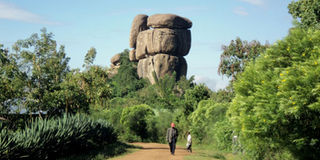How the Luo, Kisii came up with names of key places

Kit-Mikayi in Kisumu County, one of the traditional sacred places frequented by pilgrims seeking divine intervention. Photo/JACOB OWITI
What you need to know:
- The name Maseno was coined by the founding CMS missionary Rev JJ Willis, when he first set up camp in the area. He derived it from the Hickory tree under which the missionaries pitched their first tent before setting up the Maseno School in 1906. The tree — carya ovalis — is known as ‘‘Oseno’’ in Dholuo and ‘‘Omseno’’ in Luhya.
Kisumu
Kenya’s third largest city derives its name from the Luo term Kisuma. The word originates from the verb sumo, which means getting the left-overs from a farm after the harvest. Kisuma is thus understood to mean a place where people meet to exchange goods. But that doesn’t directly mean a market, which is instead referred to as Chiro.
People going to the precursor of the modern city would say, “Adhi Kisuma” or “I am going to trade.” Like many other places in Kenya, the etymological evolution occurred when the name was recorded by the administrative officials as Kisumu. To most locals the city’s name remains Kisumo.
Its previous name, Port Florence, was only used for a single year. Florence Preston, the woman after whom the Port was named, was the wife of the railway engineer. After it became an administrative centre, it reverted to its Dholuo equivalent, Kisumu.
Kit Mikayi
One of the historical sites on the Kisumu-Bondo road, is the famous Kit Mikayi weeping stone. The name directly translates to “first wife’s rocks” or “stones of the first wife” in Dholuo. The rock is said to be named so because Mikayi — the first wife — went up the rocky mound to weep after her husband took in a second wife.
Another legend claims that an old man called Ngeso fell in love with the rocks and would spend his day in the cave between the rocks. His first wife would deliver food to him up there. Eventually, the place acquired the reference, “Kit Mikayi”.
Lake Victoria
Africa’s largest lake was named after the British Monarch Queen Victoria by John Hanning Speke. Victoria is the feminine form of Victor. Both forms are derived from Latin word for victory — Victoria.
The lake is known as Nam Lolwe to the Luo and Nalubaale to the Baganda. In the Buganda kingdom, Lubaale was a saint who performed miracles. Nalubaale thus translates to “many saints”. Their shrines were situated in islands on the lake, where they would come together to pray for rain and other things.
The lake was Ukerewe to the Arabs and has also been referred to as Victoria Nyanza and Sango.
Migori
This town gets its name from Mi igori, which is Luo for “hit yourself.” When the first Luos settled in the area, it was highly infested with mosquitoes, known as suna in Dholuo.
Incensed by the constant mosquito bites and buzzing, they would complain, “Ka Suna mi’igori”, meaning, “Here, mosquitoes make you hit yourself.” This morphed into Suna Migori. The resulting urban centre retained the latter part of the phrase.
Bondo
Bondo has two meanings in Dholuo: “Valley” and “bald head”. Although it has some meaning in Luo legend, its actual application is the former. In central Nyanza, it is the sunken place between the plane lands of Ahero and Kano.
There is also a Bondo in Switzerland. It is known as Bundth in German or Buond in Romansh. The two Bondos are nonetheless unrelated.
Maseno
The name Maseno was coined by the founding CMS missionary Rev JJ Willis, when he first set up camp in the area. He derived it from the Hickory tree under which the missionaries pitched their first tent before setting up the Maseno School in 1906. The tree — carya ovalis — is known as ‘‘Oseno’’ in Dholuo and ‘‘Omseno’’ in Luhya.
Homa Bay
The town and bay on the south shore of Winam Gulf of Lake Victoria is so named because it is near Mount Homa. Mount Homa forms a broad peninsula about 20 kilometers north of the town with the same name. It is one of the few carbonatite lava volcanoes in the world.
The Luo name of the mountain is Got Marahuma or famous mountain. It was once the headquarters of the entire South Nyanza district.
Mbita
Although the phrase Mbi ta in Dholuo means “past the horizon in the water”, some people claim it got the name from witchcraft activity called mbi, meaning silence.
Gem
In Dholuo, gem means “wild”. It is unclear where the name comes from, but it was the last part of Siaya to be inhabited. The name could have been used in reference to the wilderness that was the area while the rest of the region was already settled.
Kisii
Kisii town was originally known as Bosongo from Abosongo, in reference to the white people who settled there in colonial times. During the First World War, British soldiers retreating from heavy gunfire by German gunboats on Lake Victoria settled in the area that is now Kisii town.
The modern name, Kisii, is the corrupted version of Gusii, the shorter form of Abagusii or Ekegusii, referring to the people and the dialect respectively. Its seven clan clusters — Getutu (Kitutu), Mugirango, Majoge, Wanjare, Bassi, and Nyaribari — give certain areas their names depending on which clans dominate the place.




